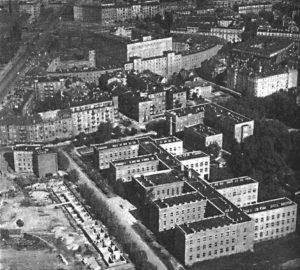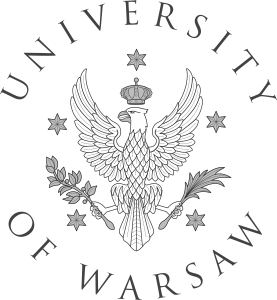History of the Faculty
History of University of Warsaw Faculty of Chemistry
The history of Warsaw academic chemistry begins with the foundation of Medical School (known also as Faculty of Academical Medicine) in 1809. It became Faculty of Medicine when Royal University was founded in 1816. The statute of Royal University from 1818 placed chemistry at Faculty of Philosophy at Third Department – Natural Sciences. At that time students attended a course of chemistry with applications that was taught by professor Adam Maksymilian Kitajewski. It is worth mentioning that chemistry lectures and practical classes were also obligatory for medicine, pharmacy and law students.
Changing attitude of the occupant towards the University affected the development of natural sciences including chemistry. After closure of Royal University chemistry was offered first at Pharmacy School, then, at Polish Medical and Surgical Academy, at Main School and finally at Russian-language Imperial University of Warsaw that was founded in 1869. The events of World War I brought reopening of the University in 1915, however, it was under German influence. In 1918 the University of Warsaw was reorganized in the independent state of Poland. Chemistry was then offered at Faculty of Philosophy, which was divided in 1927 into two faculties: Faculty of Liberal Arts and Faculty of Mathematics and Natural Sciences. Chemists conducted research and taught classes at Faculty of Mathematics and Natural Sciences, but in 1951 they transferred as a new faculty emerged, Faculty of Mathematics, Physics and Chemistry. In 1955 the next division brought the foundation of University of Warsaw Faculty of Chemistry.

In late 1910’s growing number of University of Warsaw students, including chemists, resulted in overcrowding of the premises that were then mainly located on Krakowskie Przedmieście Street. There was an urgent need for expansion and, as a consequence, Chemistry Building located on Pasteura Street in Ochota district was built. However, some time passed before it could have been used by the academic community because of the World War II. The history of the building started in 1934 when the University was given a plot with a surface area of 13.526 m2 that was located on the corner of Pasteura and Wawelska Streets. Hypothecary address for the plot was 17 Wawelska Street and it was next to the Radium Institute. In this place the Chemistry Building was built, however, it was not the first location that had been considered. Back in 1919 there was an intention to grant University of Warsaw a part of area called ‘Pole Mokotowskie’ that was then used as landing ground. In December 1922 an architect Tadeusz Zieliński developed a design for an academic town. That design was mainly fulfilled by the middle of the last century as today’s Ochota Campus. In 1924 the area was already set, however, financial crisis in Poland in 1928-1929 prevented the construction. At that time only a dormitory in Narutowicza Square was built. Thanks to many people’s efforts, among others University of Warsaw Rector professor Stefan Pieńkowki and University of Warsaw professors: Kazimierz Jabłczyński, Wiktor Lampe and Mieczysław Centnerszwer and Warsaw University of Technology professor – architect Aleksander Bojemski, and also thanks to the support of chemistry professors: Republic of Poland President Ignacy Mościcki and Minister Wojciech Świętosławski and also Deputy Prime Minister chemical engineer Eugeniusz Kwiatkowski the construction of the Chemistry building began on 19 September 1935. It is worth stressing out that the excavation were done according to the original design that was changed in 1936 as the construction of the building was split into two stages. As a result, the building was smaller and did not reach Wawelska Street and Miecznikowa Street. Except the expansion from 1960’s the second stage of the construction never happened and the whole original design was never completed. The construction works were going fast. The foundation stone was laid by Republic of Poland President Ignacy Mościcki on 29 May 1936 and the dedication ceremony took place already on 23 June 1939. Unfortunately, the new and modern Chemistry Building could not be used for a long time as in September 1939 the World War II started and the building was situated on the brink of Warsaw defence. Since the first days of occupation the Germans started robbing equipment, furniture and research apparatus. The building became a backup field hospital and in May 1941 a Wehrmacht field hospital that had one thousand beds was organised there in order to prepare for the German-Soviet War. Wounded soldiers were transported from railway station to the hospital by trams as tram line was specially built for this use. Little is known about what happened in the building during the war, however, devastation of the rooms done by the occupant could be clearly seen after the war. During Warsaw Uprising the Chemistry Building did not suffer much damage, the field hospital had been evacuated at the end of July 1944 and a few Wehrmacht soldiers that occupied the Radium Institute were of no interest to Polish forces in Ochota district. At the end of 1944/beginning of 1945 just before leaving the building, the Germans blew up a part of it. From the first days after the war efforts have been made to rebuild the Chemistry Building and start teaching classes for the first postwar year of students. These were first classes since the opening ceremony that had taken place 6 years before! Unfortunately, the postwar reality was unfavourable. Because there was no appropriate facility and there was a field hospital in the Chemistry Building during German occupation Ministry of Public Security intended to organise a hospital there. It took much effort to convince the officials that this would be unreasonable, since the building was originally designed with chemical research in mind. It was argued that before the war professors and architects made journeys to Western European countries to find the best designs and solutions for such a research facility and then implement them for the Chemistry Building. Moreover, special construction materials were used and specific equipment was provided in order to create a modern research facility that would preserve its excellence for many years to come. Strong walls and efficient installation still make it possible to modernise the building and adapt it to today’s needs. Finally, the building was granted to University of Warsaw at the end of July 1945. The reconstruction of destructed rooms and complement of windows and doors that were looted by locals begun. Thefts happened even despite the presence of armed guards. Professor Wiktor Kemula made extraordinary contribution to the reconstruction and renovation of the building. He was a landlord for many years and made great effort to obtain funds for necessary works. Finally, the reconstruction of the part of the building that had been blown up finished in 1951. However, some laboratories and lecture halls were functioning before that time making it possible for many students of Faculty of Mathematics and Natural Sciences to learn. Furthermore, some research departments of Faculty of Geology took refuge in the Chemistry Building for several years.
 University of Warsaw Faculty of Chemistry that was inaugurated in October 1955 was the first self-contained faculty of chemistry in Poland. Chemistry Building that is located at 1 Pasteura Street became its premises. There were numerous attempts to expand the building according to an architectural plan that was created before World War II, however, the results were not as spectacular as expected. In 1964 a new part of a building was commissioned, but south and north wings that were on the original blueprints will probably never be built.
University of Warsaw Faculty of Chemistry that was inaugurated in October 1955 was the first self-contained faculty of chemistry in Poland. Chemistry Building that is located at 1 Pasteura Street became its premises. There were numerous attempts to expand the building according to an architectural plan that was created before World War II, however, the results were not as spectacular as expected. In 1964 a new part of a building was commissioned, but south and north wings that were on the original blueprints will probably never be built.
In the mid-1950’s the Faculty Council started to discuss expansion into a new building where radioactive elements and compounds would be studied. According to optimistic assumptions the new building was supposed to be commissioned in 1959, however, it happened in 1965. The Radiochemistry Building is located on Żwirki I Wigury Street.
In 2010 the first stage of construction works on The University of Warsaw Biological and Chemical Research Centre (CNBCh UW) began. The second stage of construction works ended in 2014. The premises of the Centre is connected with University of Warsaw Faculty of Biology by an above-ground walkway and the Radiochemistry Building is somehow build into the CNBCh UW building. The Centre is a joint venture of University of Warsaw Faculty of Biology and University of Warsaw Faculty of Chemistry.
It is worth reminding that the first plans for campus in Ochota district were drawn in late 1922. The first building to be built on Ochota Campus was the Chemistry Building. The construction works started in 1935.
Over the years a few thousands of students have graduated from Faculty of Chemistry, a significant number of doctoral students have been promoted and numerous researchers and scientists have got their degrees and scientific titles.
Tłumaczką tekstu w języku polskim, opracowanego przez dra Zbigniewa Wielogórskiego, jest Katarzyna Jakubowska

